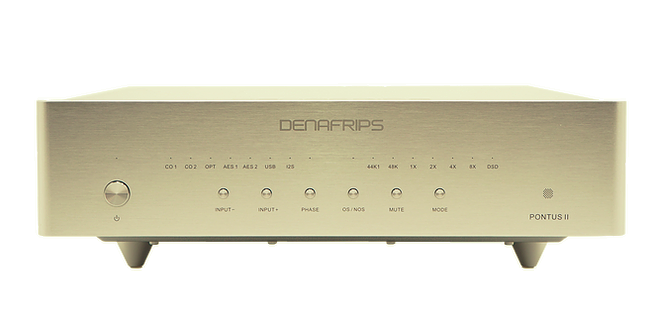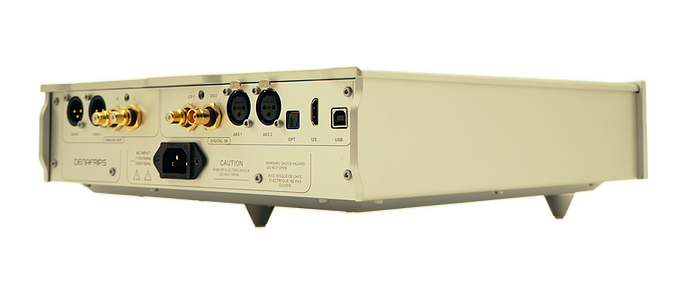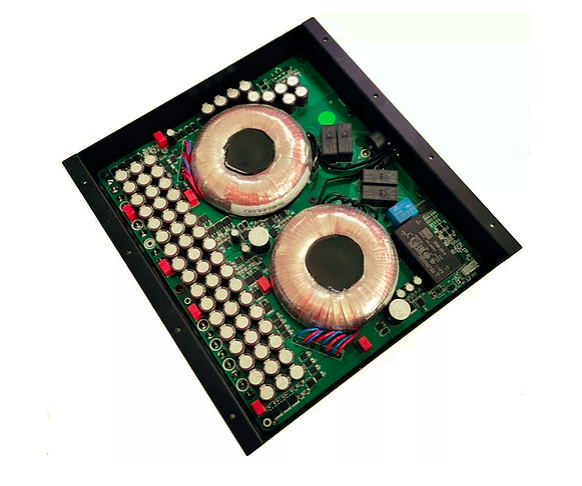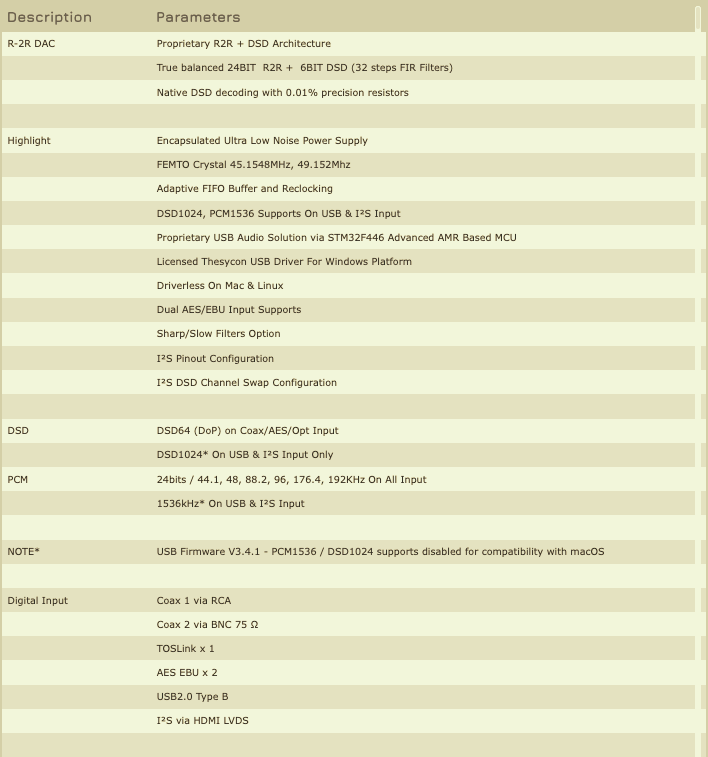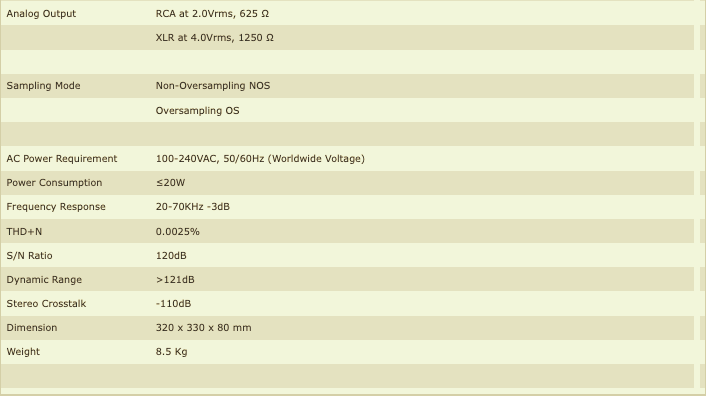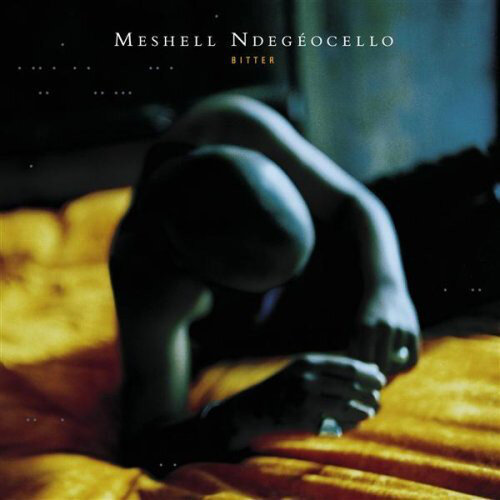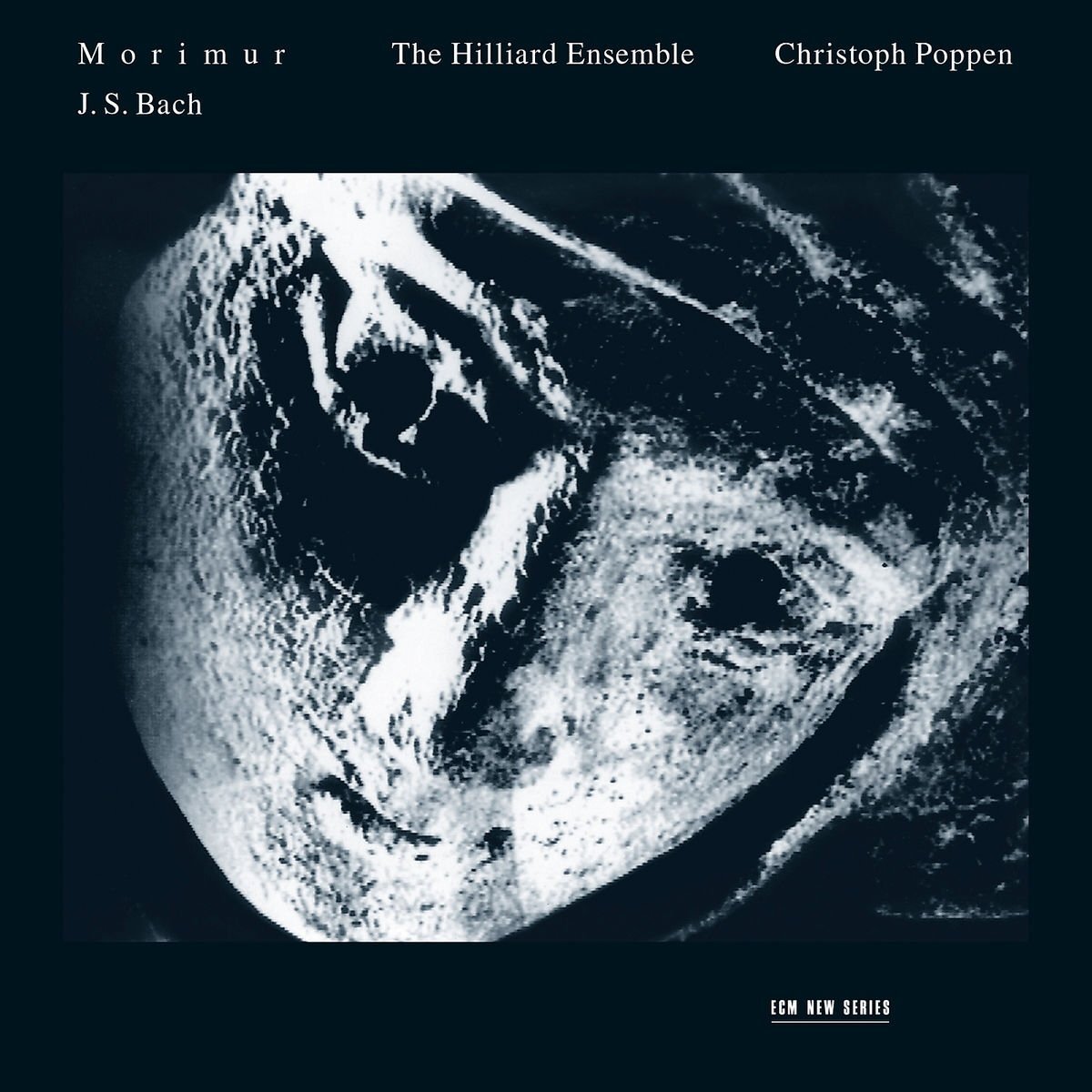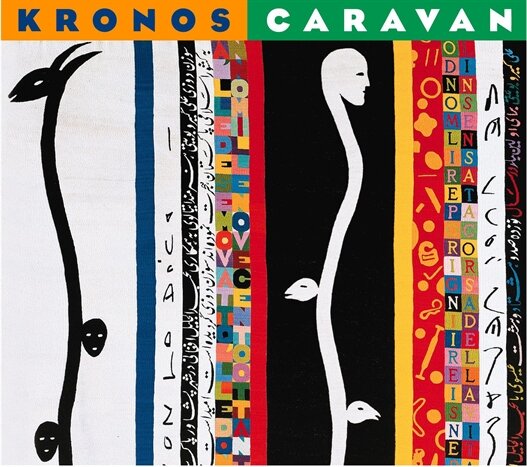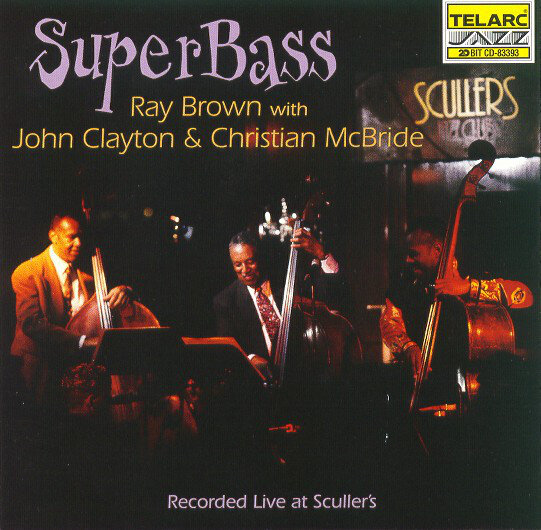DENAFRIPS PONTUS II -REVIEW
Sublime Musicality for the Masses!
In terms of access to, literally, millions of songs 24/7/365 and a wealth of playback modalities—streamers, computers, phones, DACs, DAPs, USB Dongles, etc—we are, decidedly, in a Glorious Age of Musical Access or GAMA, as mentioned across my earlier reviews. Additionally, we are witnessing the continual leap-frogging of technology that sees rapid improvements on almost a quarterly basis. This is, in turn, bringing truly sublime musical playback to a greater number of people and for a fraction of the cost of just a few short years ago. And these new, much less expensive components are giving cost-no-object components a frighteningly good run for their money! Frighteningly good!
This brings us directly to the Denafrips Pontus II ($1700) review and its rather startling abilities as an “entry” level DAC. For all intents and proposes the Pontus II is posing, with exceptional skill and ability, as a cost-no-object DAC, despite its real-world cost. In times past, the Denafrips Pontus II would, no doubt, be considered a “giant-killer.” I would, however, consider it a bit more than that, as it appears to dispense with giants so regularly, that it is more accurately a giant itself, feigning entry-level status.
The company DENAFRIPS had caught my attention as I researched other DACs and systems and streamers, in consideration of those to be sought out for review and those to be sidestepped at least for now. I reached out to Alvin Chee, the owner of Vinshine Audio and the distributor of the DENAFRIPS line, to seek out a sample for review. Alvin graciously agreed and soon thereafter a DENAFRIPS Pontus II was on its way for evaluation and review.
What I would discover after the Pontus II’s placement in my reference system and the recommended ten days of burn-in was something that nearly 40 years as an audiophile could not have prepared me for! And what was that you ask?
REFRAIN: Unlike most reviews, this review will be non-sequential, as it will start with how the headphones actually sound and not the process of physically “undressing” them and/or laying out their various parts, specifications, etc. Think of this review then, as a non-linear movie—Memento, Kill Bill, Arrival, Eternal Sunshine of the Spotless Mind, etc—that, likewise, starts at the end and winds its way to the beginning.
The Sound
Truly spectacular! In terms of pricing the Pontus II was always the ‘baby’ of the various reference systems, as all the other components were multiples of its cost. Despite this fact, the DENAFRIPS Pontus II always held its own and could well be called an extremely high achiever or a prodigy, when it came to ushering out the various bits of musical information and in a rather profound manner.
The best analogy for this would be as if a young man sat in the front row of a jazz concert, with trumpet in hand, as he listened to the greats perform. So joyful is he at hearing their music, that the jazz performers can’t help but notice and they invite him up to play a set. Perhaps as a humorous bid, perhaps just curious. After all, who carries their trumpet to a performance? However, when he hits the stage and begins to play, it is clearly evident that his talents are prodigious, as he finishes out the set with great applause from the audience, and great applause, as well, from the jazz masters on stage.
This then is the DENAFRIPS Pontus II, which performs far above its price point and into five-figure territory when it comes to pricing. There is just no other way to speak to the Pontus II’s daunting skills as a DAC across the entire frequency spectrum and how it ties everything together so coherently, so transparently, and so musically. In truth, its performance has been breathtaking!
Its voice is exceptionally detailed, rich (texturally and tonally), beautifully engaging, with a soundstage that is, perhaps, one of the deepest that I have heard. And the Pontus II’s incredible holography—three dimensionality—and its phenomenal resolution has found it adopted, as a family member, by electrostatic headphone amplifiers and electrostatic headphones, that are better still for its inclusion! And, of course, it performs beautifully with dynamic headphones and headphone amplifiers and, in particular, with the LTA Z10e that is fluent in both languages—dynamic and electrostatic.
The Pontus II’s separation of players across the width and the depths of a soundstage—where they are physically located, in any given recording—is phenomenal, as is the air and the space which surrounds them. This brings a realism to one’s music, that time after time causes quite a bit of head-shaking. “How is this possible?” I’d ask. And then there is the liquidity. Liquidity? Yes, the unimpeded, analog-like flow, the smooth, natural engagement of the music, that drops one’s shoulders, releases the furrowed brows, and brings a relaxed calm (given one's music, of course).
Did I mention the incredible dynamics, wherein the Pontus II reveled in the softest of passages (pianissimo) and easily rode the loudest of passages (fortissimo) as if a skilled bronco rider. This is something that far more expensive DACs have often failed to do. And its blazing, stop-start-on-a-dime transient speed startled time and time again! At one point, I stopped the music and evaluated what I had just heard. This, dear reader, is rare, as 40 plus years in audio have ingrained a good deal of cynicism when it comes to audio gear, in general, and bargained priced gear, in particular.
Some components back one’s process up. Or, more specifically, so good are they, that they command more of your time and, as a result, they hold up the reviews of other components. This completely tweaks one’s review schedule and, no doubt, ticks off manufacturers whose products are in that queue. The Pontus II is one of those products.
The DENAFRIPS Pontus II’s volumetric cube—its soundstage—is one of the largest that I’ve encountered. Perhaps this is a result of the synergy found with either the LTA Z10e or the STAX SRM-T8000 headphone amplifiers, the Roon Nucleus Plus streamer, and the various headphones—STAX SR-009S, SR-L700MkII, Meze Empyrean, etc. And across its soundstage, as mentioned above, there is superb separation and layering and a three-dimensionality, that together conjure a truly convincing stage and surprising realism. Realism is a word that I don't use much across my reviews, but it is more than appropriate here given the Pontus II’s ability to transport you to the musical venue—cafe, stage, opera house, symphony, etc.—in question.
The DENAFRIPS Pontus II DAC for the purpose of the review was allied with the electrostatic/dynamic headphone amplifier—the LTA Z10e—the electrostatic headphone amplifier—the STAX SRM-T8000—the various electrostatic and dynamic headphones—STAX SR-009S, STAX SR-007A, Dan Clark VOCE, MEZE Empyrean— the Roon Nucleus Plus, and the TORUS RM20.
Bass
Foreboding. Transparent. Detailed. Fast! These are the words taken directly from my notes with regard to the DENAFRIPS Pontus II’s portrayal of the bass across, literally, every bass track that it rendered. And while there were those systems that did not provide the synergy necessary to usher the Pontus II into the stygian bass depths, there were certainly those that did. Synergy. As Eiji Oui’s “V. Infernal Dance of King Kashchey” (Stravinsky, Reference Recording) begins, it is dramatic, formidable, and startling. The Pontus II as allied to the STAX SRM-T8000 and the STAX SR-009S descend easily to the sub-bass regions and take hold of the Holy-Bass-Head-Grail, a confident smile shared between them. Thunderous is the pummeling of the timpani and the various kettles (7) that have been assembled for this movement and foreboding is what lies just ahead. And when it comes, via the rapid pummeling of all seven assembled kettles, there is little to no difference between this and the tumultuous thunder, just beyond the walls, that rumbles across this Midwestern, rain-soaked clime. Beautiful! Marcus Miller’s “Power” (M2, Concord) powers in to join the fun and helps to further define the Pontus II's bass not only as potent and thunderous but also lickety-split quick (as in its transient response), beautifully transparent, textured, with screaming dynamics! Regardless of the amount of bass thrown at the Pontus II, in this system it is always up to task and a willing traveler to the stygian bass depths of what any track called for. Synergy.
Midrange
Transparent. Detailed. Luxuriant. Compelling. Real. Often these descriptors, again pulled from my notes, would be mutually exclusive, as they do not normally exist within a single component and certainly not at this price point. The Pontus II embraces a phenomenal Ying/Yang portrayal of the music. Olafur Arnalds' “Árbakkinn” (Island Songs, Mercury (Universal France)) queues for play and the palpability, the realism, the immediacy is stunning, as Icelandic poet—Einar Georg Einarsson—recites his poem. There is no digital artifice with the Pontus II that puts one on edge or makes one uncomfortable or that will soon fatigue. The DENAFRIPS Pontus II excels at vocal realism and clarity, articulation and diction, that more often than not removes the guesswork of trying to determine what a singer or a chorus is actually singing! This consistently brought on momentary reviewer catatonia or shock! How is this possible? And all that was left for me to do was just listen, as I could neither review nor take notes. Tone, timbre, and texture were outstanding, as was the ability, via the Pontus II, to see deeply into the stage and across its breadth. The birds, I forgot the birds. In Olafur Arnalds’ “Árbakkinn” the birds that are outside the recording venue always come in at some point, as the mikes are able to pick them up. Though what I did not realize, until much later, was that the birds come in and can be heard, with the proper DAC—Pontus II, Mola Mola Tambaqui—from the very beginning! I was even able to gain further insight into Shirley Horn’s “Beautiful Love” (You Won’t Forget Me, Verve) a song that I have been listening to for over 30 years! Shirley’s voice inflection, her breathing, the pursing of her lips, the subtle, slight vibrato, an indrawn breath, her diction were all laid bare. The Pontus II would repeat this talent across an array of vocal tracks, regardless of genre. What all of the above speak to is a transparency coupled to a rich and engaging musicality, that allows the Pontus II incredible insight to any and all recordings. But how is this possible in a DAC at this price point?
Treble+
Incredibly extended. Detailed. Unencumbered! I smile now and shake my head, as Hilary Hahn’s “Sonata for solo violin No. 1 G minor, BWV 1001: Adagio” (Hilary Hahn Plays Bach: Violin Sonatas Nos 1 & 2; Partita No. 1, Decca) plays. It is vibrant, energetic, transient quick (start and stop ability), transparent, with a richness of tone/timbre that is exceptionally engaging. It is as if I am on stage immediately beside Hilary, so real is the Pontus II’s portrayal of this movement. My Yellow-Chair-Tardis and I take these kinds of trips across time and space, figuratively speaking, that place us at many past musical events and, especially so, with the electrostatics (headphones and amplifiers). The LTA Z10e (electrostatic headphone amplifier) and the STAX SR-009S (electrostatic headphone) as coupled to the DENAFRIPS Pontus II have powered up things for this trip to hear Hilary Hahn and others. To the jazz fans, do you think that you've ever, truly, heard Dave Brubeck’s “Take Five” (Time Out, Columbia-Legacy) CD? Well, I thought I had until I engaged the electrostatics and the Pontus II. What you will realize very quickly, if you are inclined to do the same, is that you've not really heard this CD, despite its 60 plus year lifespan. What the electrostatics and Pontus II (and the Mola Mola Tambaqui prior) do is to make things, entirely, three-dimensional, alive, vibrant. Three dimensional in that the stage is now layered with musicians at different depths across it, as opposed to all of the musicians lined up in a row, across the stage—flat. This, generally, doesn’t happen in performances (see orchestra, etc.), any performances. And there was never harshness or grain or stridency or sibilance with the Pontus II in the mix, regardless of the system employed. The Pontus II’s treble extension easily shot past the moon to points beyond (Alpha Centauri?). One day, of all things, my Yellow-Chair-Tardis, the electrostatics, and the Pontus II even took us past a barn on the way to a concert! There was music playing and a guy was well, hanging from the rafters! Don’t quite know who he was or what that was about. I imagine that we crossed wavelengths, or some such thing though, for a reason. However, with regard to the DENAFRIPS Pontus II, this is not a $1700 DAC though it is priced as such. Amazing!
The Wrappings and Accessories
The DENAFRIPS Pontus II DAC comes in a nondescript cardboard box, which does not indicate the contents therein, at least, in English. Inside the box is a thick, black, hard-foam case that hold and protects the Pontus II and I would, imagine, relatively well. It arrived completely unscathed. Also inside the box is a plastic card which serves as a certification of authenticity. And that’s it folks. There is no power cord.
Apparently, the production funds have all gone into the Pontus II and not a stylized or graphically spectacular outer box or ancillaries. However, given the Pontus II’s abilities, as mentioned above, fair enough. There is one “accessory,” if I might call it that and that is the 3-year warranty that is applied to all DENAFRIPS products. Stellar and quite rare!
Design—Look and Feel
Rock solid. Elegant. Smooth. Beautifully constructed. These words and phrases are from the notes that I took as I inspected, lifted, shot pictures of, and admired the DENAFRIPS PONTUS II. The Pontus II's case work is that of solid, silver-coated, brushed aluminum. You’ll not mistake it with an entry level audio product, as for one thing, it’s heavy. Which brings us to the hated lawyer’s response in Jurassic Park, “Is it heavy?” … “Then it’s expensive, put it back.” The DENAFRIPS PONTUS II is, indeed, heavy, but not expensive, relatively speaking.
Its front face bears an on/off switch far left, six, smallish, metal buttons centered across its face, and 16 incredibly tiny lights from right to left that indicate connection—coaxial, optical, balanced (AES/EBU), USB, and I2S—phase, oversampling/non-oversampling, mute, and sampling rate—44.1K, 48K, 1X, 2X, 4X, 8X, and DSD. The DENAFRIPS logo sits centered at the top edge of its face and the series designation—Pontus II—at the bottom right corner of the front face.
Its rear face from left to right features balanced and single-ended outputs, seven digital inputs—coaxial (2), AES/EBU (2), optical (1), I2S (1) and USB (1). Its IEC socket for connection to power is centered at its lower edge. It is a very simple, clean, and straight-forward affair.
The above said, it is rather difficult to match the DENAFRIPS PONTUS II build quality to its price, as its case also speaks to a far more expensive product at, perhaps, multiples of its cost. Suffice to say, that the DENAFRIPS PONTUS II is a beautifully executed and industrially-designed product.
Functionality
R-2R DAC: R-2R Digital-to-Analogue Converter, or DAC, is a data converter which use two precision resistor to convert a digital binary number into an analogue output signal proportional to the value of the digital number.
The DENAFRIPS Pontus II DAC is a balanced, 24-bit, proprietary R-2R DAC, that supports sampling rates of up to 24-bit/192kHz across all of its digital inputs. Further, the Pontus II supports up to DSD1024 On USB & I²S Inputs and 1536kHz On USB & I²S Inputs.
The Pontus II is equipped with the various digital inputs:
1 - Coax via RCA
1 - Coax via BNC (75 Ω)
2 - AES/EBU
1 - USB
1 - I²S via HDMI LVDS
The Pontus II is relatively easy to sync to one’s system, though there is a brief online tutorial to help things along, quite nicely with regard to setup.
(Please find additional specifications below)
The Specifications
Conclusion
The DENAFRIPS Pontus II’s talents are prodigious and when its price is considered, relative to the incredibly expensive DACs and the way-over-the-top, incredibly expensive DACs, it is, decidedly, in the mix and on stage with the best and a giant killer! No doubt, its performance sends shivers down the spines of the makers of the way-over-the-top, incredibly expensive DACs, as well it should. I can't even begin to imagine what its big brothers—Venus II, Terminator II, and Terminator Plus—are capable of. Double yikes!
The Pontus II is a champion of resolution and detail, a champion of dynamics, transient speed, and staging, and a champion of a realism and musicality that is so engaging, so texturally and tonally rich, as to present a rather mystifying conundrum. How could all of this, coupled to an elegant, beautifully constructed, and rock-solid case come in at its current price point? STAMPEDE! Or, at least, the DENAFRIPS Pontus II conjures images for me of people stampeding to purchase one.
The DENAFRIPS Pontus II is a three-star Michelin meal, that continually remakes itself, depending on the music played, into another, quite delicious, different three-star Michelin meal. My only fear now is that I may well have to repeat myself, which I do not like doing, with its big brothers.
We, AudioKey Reviews, highly recommend the DENAFRIPS Pontus II DAC and award to it our GOLDEN KEYNOTE AWARD for superb musicality and resolution and spell-binding engagement, so far above its price point as to present a dilemma for the makers of the way-over-the-top, incredibly expensive DACs. Finally, technological innovation delivers superb musical playback to a much broader audience than ever before. Suffice to say, that one of the DENAFRIPS DACs, if not the Pontus II, will find a loving home here at AudioKeyReviews. Bravo!
Pros: An incredibly natural, transparent, and exceptionally musical DAC that will boggle one’s mind (it boggled mine) and especially so at its price point. Not just a giant killer, a giant in disguise!
Cons: …
The Systems
1.
Roon Nucleus+
STAX T8000
Dan Clark VOCE
STAX SR-009S
STAX SR-L700MkII
ANTICABLE/CARDAS cabling and wires
TORUS RM20
2.
Roon Nucleus+
LTA Z10e
MEZE Empyrean
Rosson Audio RAD-0
Dan Clark VOCE
STAX SR-009S
STAX SR-L700MkII
ANTICABLE/CARDAS cabling and wires
TORUS RM20
THE MUSIC
The Company
DENAFRIPS
DENAFRIPS PONTUS II ($1700)
DENAFRIPS
support@denafrips.com
The DISTRIBUTOR
VINSHINE AUDIO
33 Ubi Avenue 3
Singapore 408868
sales@vinshineaudio.com
Wechat: vinshineaudio
Whatsapp: +6588534576
